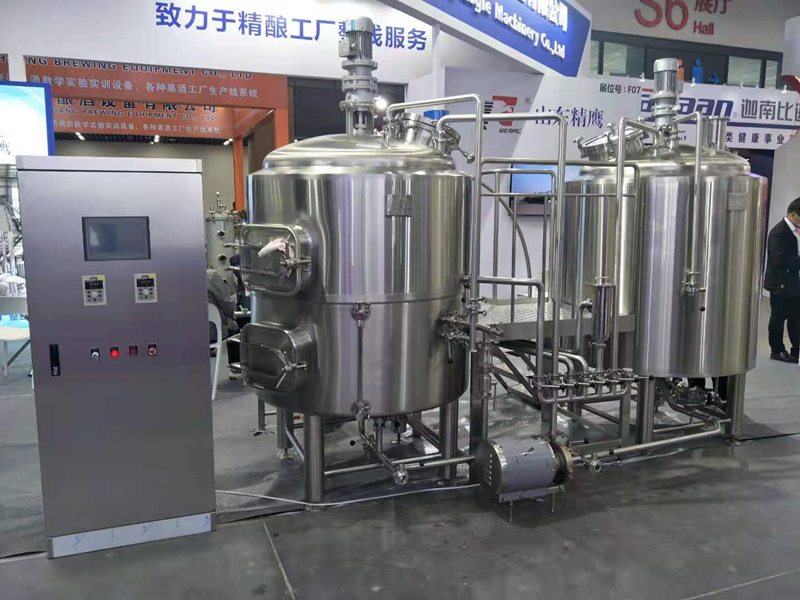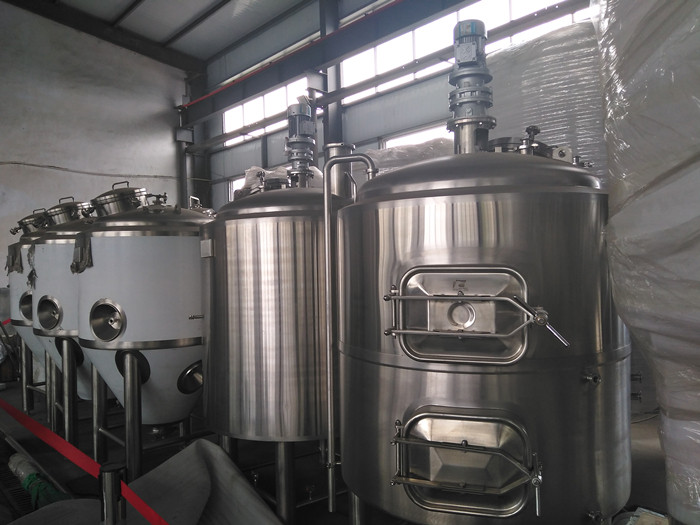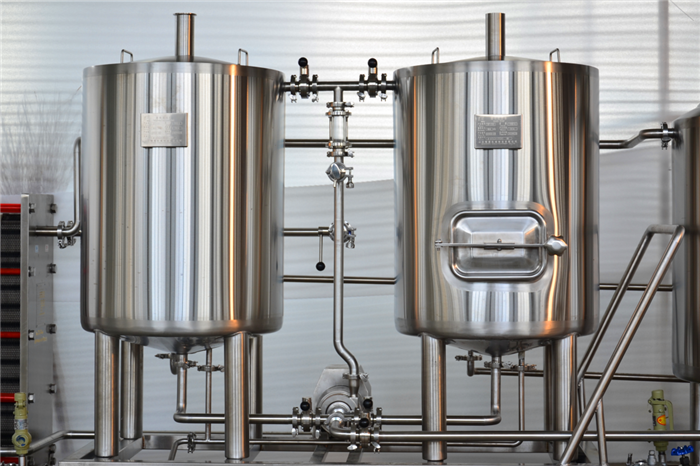
500L 1000L 3BBL 5BBL Two vesssels craft beer making microbrewery brewing system ZXF
- * Processing : Fermenting Equipment, Beer Brewing
- * Brand : WEMAC
- * Condition : New
- * Material : SUS 304 316
- * Place of Origin : Weifang, China (Mainland)
- * Control system : AUTO/MANUAL
- * Warranty : Within 24 months against the date of B/L
- * Voltage: : To Be Determined (220V/ 380V/ 415V)
500L Craft beer brewing system1000L two vessels beer making microbrewery3BBL beer making microbrewerytwo vessels craft beer brewery

It looks like you're mentioning different sizes of brewing systems commonly used in microbreweries to make craft beer. Let me break down the terms for you:
500L: This refers to a brewing system with a capacity of 500 liters (about 132 gallons). It's the amount of wort (unfermented beer) that can be produced in one batch using this system.
1000L: Similarly, this refers to a brewing system with a capacity of 1000 liters (about 264 gallons). It's larger than the 500L system and can produce more beer per batch.
3BBL: "BBL" stands for barrels. A 3BBL brewing system can produce 3 barrels of beer per batch. One barrel is equivalent to 31 gallons or 117 liters. So, a 3BBL system can produce approximately 93 liters of beer per batch.
5BBL: This refers to a brewing system that can produce 5 barrels of beer per batch, which is about 155 gallons or 586 liters.
In the context of microbreweries, the choice of brewing system size depends on factors like production goals, space availability, and budget. Smaller systems like the 500L or 3BBL are suitable for smaller microbreweries or brewpubs with limited space and lower production volume, while larger systems like the 1000L or 5BBL are better for those aiming to produce more beer per batch.
The "two vessels" aspect typically refers to a simplified brewing setup where the brewing process takes place in two main vessels: the mash/lauter tun (where mashing and lautering occur) and the kettle/whirlpool (where boiling and whirlpooling occur). This is in contrast to more complex systems with additional vessels for specific purposes like sparging or separate whirlpooling.
Keep in mind that the craft brewing industry is diverse, and there are many variations and configurations of brewing systems, each with its own advantages and considerations. If you're interested in setting up a microbrewery or learning more about brewing systems, it's a good idea to consult with experts in the field and conduct thorough research.
(1).Brewhouse
Δ. 2-vessel: mash/lauter tank and kettle/whirlpool tank;
Δ. Combination tank: Mash lauter/whirlpool tank, kettle tank;
Δ. 3/4 vessels is also available if pub brewery space and operation needed;
Δ. Hot water tank optional.
(2). Heating method Of The Brewhouse
Electricity heating/ steam heating(electricity/LPG/diesel oil/nautral gas)/ direct fire heating method
(3).Material Of All The Tanks
Interior stainless steel 2.5~3.0mm, exterior stainless steel/luxury red copper cladding 1.5~2.0mm
Δ.High quality materials
The raw materials is SUS304 and SUS316, which require materials quality certificate.
We’ll test the materials quality using chemical agent when we receive the materials
Δ.Excellent appearance
The polishing standard of welding seam is 240 um, 60mm width. All of connection required turn up workmanship and all of welding seam required polishing, which is more smooth tank surface. We’re very serious about the excellent appearance of tanks.
Δ. Insulation layer: Polyurethane or rockwool, thickness 80~100mm
(4).The Standard Of BreweryTank
Δ. We use plasma torch to cut the materials on the soft carpet, avoid to damaging the surface of stainless steel, and then we adopt double argon protection welding.
Δ. Volume: Working volume and 20%-30%additional space.
Δ. Inner Shell: SUS304 materials, thickness 3mm, acid washing and passivation treatment, furthermore,polishing and mirror treatment are workable with different cost.
Δ. All of the inner surface connection using turnup workmanship and polishing round.
Δ. The normal pressure is 0.2Mpa, maximum test pressure is 0.4Mpa.
Δ. Cladding: SUS304, 2mmthickness, welding seam polishing, 60mm width.
Δ. All of the welding connection polishing treatment, more smooth

Mash tun,inner stirrer,drived by the upper motor,Make the mashing process more uniform and stable.

Plate heat exchanger,also equipped with chiller and cooling water tank,two stages cooling,Keep the fermentation broth at a suitable temperature


Imported large-screen PLC control system display screen, displays the current time, system overview, automatic temperature control, can display historical fermentation records, process curves, etc.

FAQ
Q1: What is a two-vessel craft beer making microbrewery brewing system?
A two-vessel brewing system is a setup commonly used in microbreweries for producing craft beer. It consists of two primary vessels: the mash/lauter tun and the kettle/whirlpool. These vessels are used for different stages of the brewing process.
Q2: What are the key vessel capacities available for this system?
This FAQ covers the following capacities: 500 liters (L), 1000 liters (L), 3 barrels (BBL), and 5 barrels (BBL).
Q3: What is the difference between the vessel capacities?
The capacities determine the amount of beer that can be produced in each batch. For reference, 1 BBL is approximately 31 gallons or 117 liters. A 500L system produces about 132 gallons per batch, while a 3BBL system produces around 93 liters and a 5BBL system produces about 155 gallons.
Q4: What stages of brewing does each vessel handle?
Mash/Lauter Tun: This vessel is where mashing (mixing malted grains with hot water) and lautering (separating liquid wort from the spent grains) take place.
Kettle/Whirlpool: In this vessel, the wort is boiled, hops are added for flavor and bitterness, and whirlpooling separates hop debris from the wort.
Q5: Which vessel is used for boiling the wort?
The kettle vessel is used for boiling the wort. During this stage, hops are added for bitterness, flavor, and aroma, and the wort is sanitized through boiling.
Q6: What is whirlpooling, and why is it important?
Whirlpooling is the process of creating a swirling motion in the wort after boiling. This helps to separate solids (like hop debris) from the liquid wort, leading to clearer wort that can be transferred to the fermenter.
Q7: Can these systems produce different types of beer?
Yes, these systems are versatile and can produce a wide range of beer styles. The choice of ingredients, hops, yeast, and brewing techniques allows brewers to create various beer flavors and profiles.
Q8: What factors should I consider when choosing a vessel capacity?
Consider your production goals, available space, and budget. Smaller capacities like 500L or 3BBL are suitable for smaller microbreweries, while 1000L and 5BBL systems are better for higher production volumes.
Q9: How can I get started with a two-vessel microbrewery brewing system?
Research and planning are essential. Consult brewing experts, suppliers, and other brewery owners. Understand your local regulations, design your brewery layout, source quality equipment, and develop your beer recipes.
Q10: Are there additional vessels that can be added to this system?
Yes, some breweries might expand by adding vessels like a hot liquor tank for water heating, a separate whirlpool vessel, or additional fermenters for more simultaneous batches.
Send a Message
If you want to ask anything just fill in the form below and send us.
Write a review
Products
- Beer brewery equipment
- Craft brewing equipment
- Home brewing equipment
- Microbrewery equipment
- Commercial brewing equipment
- Industrial brewery equipment
- Pilot brewing system
- Brewhouse & Mash system
- Fermentation tank
- Bright / Brite tank
- CIP system
- Beer filling machine
- Pasteurizer
- Hop gun
- Yeast propagation equipment
- Beer concentration equipment
- Carlsberg flask
- Reverse osmosis water filtration systems
- Mobile water treatment systems
- Water Purification Equipment
- WFI equipment
- Purified water tank
- CIP system
- Multi effect water distiller
- Pure steam generator
- WFI tank
- Solution preparation tank
- Tube heat exchanger
- Storage and distribution system
- Liquid preparation system
- Demineralized water system
- Vapour compressor
News & Exhibitions
- Why Beer Concentration Matters: Unpacking the Standard ABV Range
- Why Every Craft Brewer Needs a Pilot Beer Brewing System
- Top 5 Benefits of Using a Pilot Beer Brewing System for Small Breweries
- Setting Up a Microbrewery? Why Turnkey Equipment Might Be Right for You
- How Nano Brewery Equipment is Changing Experimental Brewing: A Deep Dive into Small-Scale Innovation
- Essential Craft Beer Equipment for Starting Your Brewery
- Integrating Smart Equipment into Your Microbrewery
- From Grain to Glass: Building the Perfect Complete Brewing System for Your Home
TAGS
- turkey brewery equipment
- small beer brewery equipment,mini beer brewery equ
- sovereign stainless steel fermenter
- brewing equipment manufacturers uk,home brewing eq
- home brewing distillation equipment
- craft brewery equipment for sale, craft beer equip
- complete brewery for sale
- beer brewing equipment
- Nano brewery equipment, brewing systems manufactur
- 15 gallon jacketed fermenter
- automatically brew equipment,50L Brewing equipment
- dry hops addition
- hops addition gun
- hop additive gun
- mixing tank manufacturers
- pilot brewing system
- Craft beer making equipment for Malaysia
- CIP system
- Microbrewery machine
- professional Cleaning in place equipment
FEATURED PRODUCTS

Belgium 2 vessels craft beer making brewery equipment ZXF
2 vessels craft beer brewery system are in discount in Belguim,all stainless steel 304 material,professional beer brewin...
More >>
2 vessel brewhouse 500L beer brewing equipment
2 vessel brewhouse 500L beer brewing equipment is the most commonly used in brewery.One of them is a mash tun,the other ...
More >>549.jpg)
single vessel electric brewing system
Single vessel electric brewing system belongs to small beer brewing system. Small space, high degree of automation, simp...
More >>
500L 1000L 3BBL 5BBL Two vesssels craft beer making microbrewery brewing system ZXF
Two vessels craft beer brewing machine,mash/kettle tun+lauter/whirlpool tun.gas steam heating,all tanks are made of stai...
More >>
Cost of 1 BBL brewing system- 2 vessels brewhouse brewtech beer mash system for sale
How to save money in the beer brewing system? 2 vessels brewhouse
Beer brewing is not a cheap project. Different from o...

Craft beer at 2 vessels brewhouse &mash system hot sell in USA
Craft beer at 2 vessels brewhouse &mash system hot sell in USA What Equipment or accessories do I Need to Start a Brewer...
More >>
6BBL Professional 2 vessels beer making brewhouse and mash system from Chinese factory ZZ
our complete set of beer brewing equipment consists the following parts:6BBL beer mash system,fermentation system,CIP sy...
More >>
Professional 2 vessels turnkey brewpub equipment of SUS304 316 for sale from China W1
Professional 2 vessels turnkey brewpub equipment of SUS304 316 for sale from China. We provide practical solutions in de...
More >>

